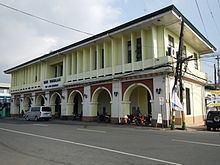Founded April 26, 1765 Local time Tuesday 6:44 AM | District 4th District Barangays Area 53.29 km² | |
 | ||
Weather 23°C, Wind N at 2 km/h, 83% Humidity Neighborhoods Lumil, Tugtug, Galamay-Amo, Balagtasin, Bigain II | ||
The town of san jose batangas philippines in 1999 and history part i
San Jose, officially the Municipality of San Jose (Filipino: Bayan ng San Jose), is a municipality in the province of Batangas in the Calabarzon (Region IV-A) of the Philippines. The population was 76,971 at the 2015 census. In the 2016 electoral roll, it had 44,157 registered voters.
Contents
- The town of san jose batangas philippines in 1999 and history part i
- Map of San Jose Batangas Philippines
- Town of san jose batangas part i
- History
- Geography
- Barangays
- Demographics
- List of former Municipal Executives
- Economy
- Attractions
- Notable people
- References
Map of San Jose, Batangas, Philippines
The municipality is bounded in the north and north-east by Lipa City, east by Ibaan, south by Batangas City and San Pascual, and west by Cuenca and Alitagtag.
Town of san jose batangas part i
History
The Aetas were the first inhabitants of the place. They started clearing some portions of the wilderness especially in areas near the riverbanks. Several groups of settlers then drove this Aetas to the hinterlands and permanently occupied the place. They named it “Malaquing Tubig”, referring to the big river that cuts through the central portion of their early settlement.
The Spaniards then colonized the Philippines. Bauan was established in 1596 as an ecclesiastical unit administered by the order of Saint Agustin with Malaquing Tubig as one of the barrios under its jurisdiction.
Human population of Malaquing Tubig started to grow and in 1754, Taal Volcano erupted destroying the original Bauan. And before its actual site could have been selected, Malaking Tubig was separated from Bauan. The recognized leaders of Malaquing Tubig then petitioned to the Spanish authorities for the creation of that place as a pueblo which was granted to them on April 26, 1765.
Established on April 26, 1765 as the town of San José de Malaquing Tubig, it once formed part of Bauan, and in the new town's establishment, it originally included the land that now makes up the Municipality of Cuenca.
Geography
San Jose is located at 13°52′38″N 121°06′18″E.
According to the Philippine Statistics Authority, the municipality has a land area of 53.29 square kilometres (20.58 sq mi) constituting 7000171000000000000♠1.71% of the 3,119.75-square-kilometre- (1,204.54 sq mi) total area of Batangas.
Barangays
San Jose is politically subdivided into 33 barangays.
Demographics
In the 2015 census, San Jose had a population of 76,971. The population density was 1,400 inhabitants per square kilometre (3,600/sq mi).
In the 2016 electoral roll, it had 44,157 registered voters.
List of former Municipal Executives
Although currently called "Mayor", the Municipal Executive of San Jose has held other names including Gobernadorcillo which means "Governor" during the Spanish Period.
Economy
San Jose is well known for growing good varieties of coffee, lanzones, and black pepper. It is where a great number of poultry and piggery animals are grown and sold, especially to Metro Manila, where it supplies a significant percentage of poultry products. Most of the San Jose workforce is either directly or indirectly involved in farming. There are also numerous feedmill corporations within its jurisdiction which include WhiteGold, Everlast, Busilac, Wincom, New Golden Mix.
Attractions
The Shrine of Saint Joseph the Patriarch located in the town proper is a popular Catholic pilgrimage site. It was once built with cogon and bamboo by Augustinian friars around 1788. The present structure was built on 1812 under the supervision of a botanist Fr. Manuel Blanco. It has single-aisled interior which offers an unobstructed view of the large main altar. The altar is massive, with six rounded columns encircling the image of Saint Joseph. Outside a multi-tiered belfry stands which was built in the latter part of the 19th century; a bridge offers passage to the church over the Malaquing Tubig River.
San Jose hosts the Oblates of Saint Joseph Mission along with its Minor Seminary, established by Saint Joseph Marello. This marks the first instance of an Italian religious congregation dispatching missionaries to the Philippines, with San Jose being their inaugural overseas mission. Additionally, it serves as the focal point for Vicariate IV within the Archdiocese of Lipa.
San Jose celebrates Sinuam Festival every 25th day of April to commemorate its founding anniversary and to thank its patron for the good performance of the main business in the town which is Poultry.
